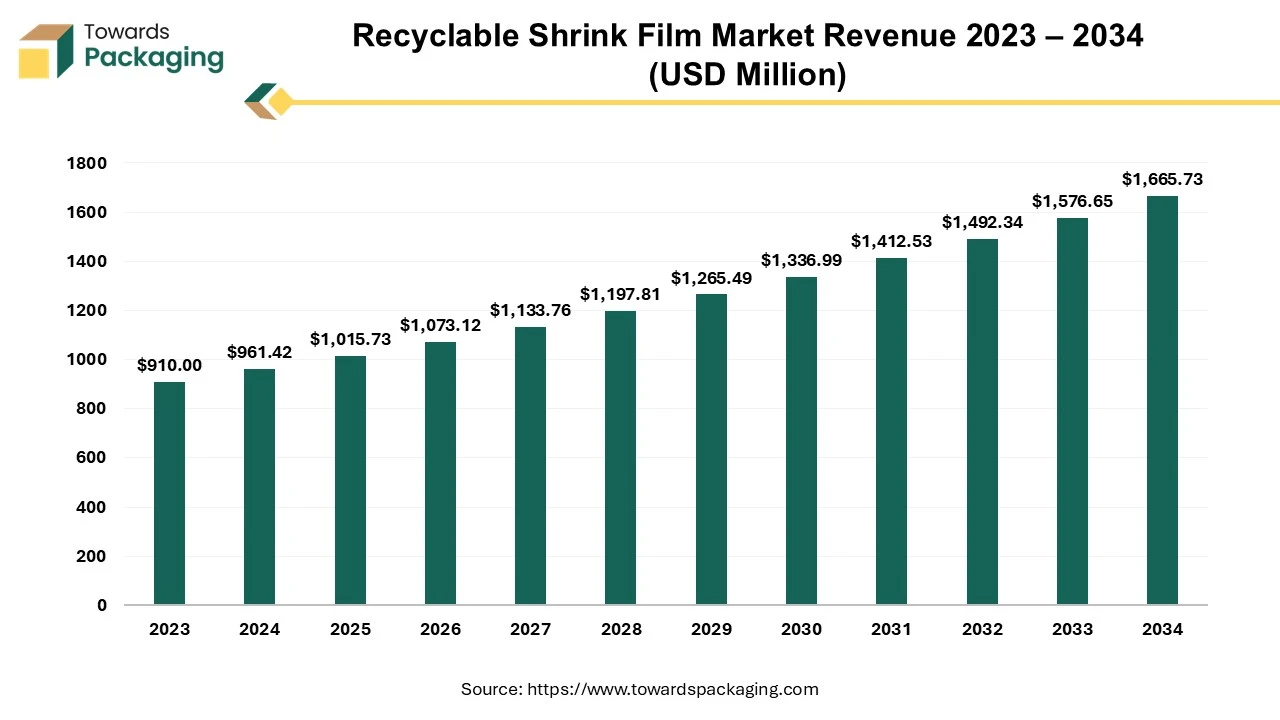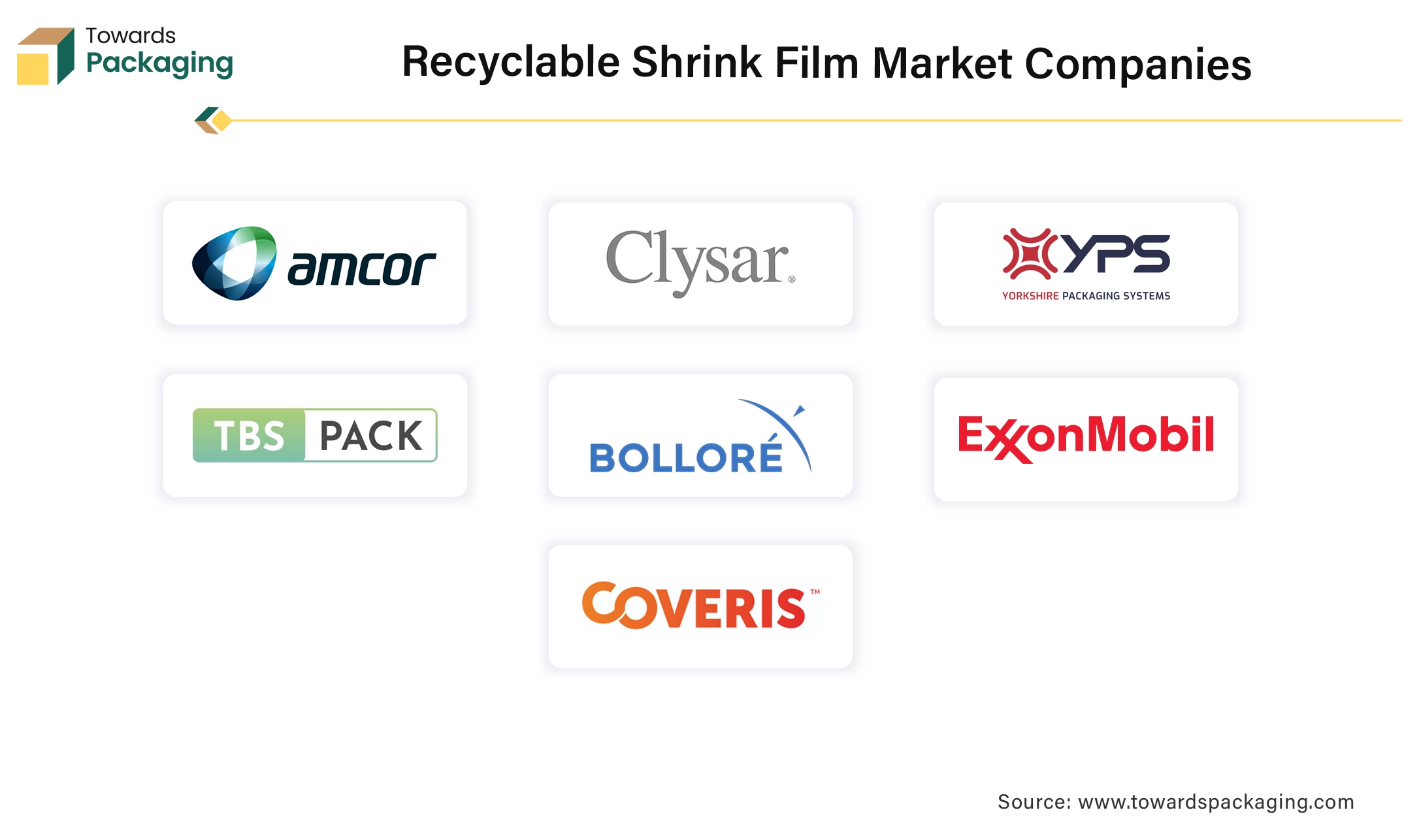April 2025
The recyclable shrink film market is projected to reach USD 1,665.73 million by 2034, expanding from USD 1015.73 million in 2025, at an annual growth rate of 5.65% during the forecast period from 2025 to 2034.

Unlock Infinite Advantages: Subscribe to Annual Membership
The demand for sustainable packaging solutions is driving the expansion of global recyclable shrink film market. increasing awareness of environmental responsibilities are encouraging circular economy. Advancement in shrink film technology is expecting to fuel market.
Recyclable shrink films are made from recyclable materials designed to shrink over on products for product protection and tamper-evidence. Recyclable shrink films have been in demand due to their capability of waste reduction and concerns about packaging's environmental impacts. The most commonly used types of shrink films are PVC, Polyethylene, POF, EVA, and some other compositors:
PVC shrink film packaging is affordable and light weight to use. However, it is banned in several countries due to its negative impact on the environment. Polyethylene: polyethylene (PE) is the most demanded shrink film, used for industrial products due to its flexibility properties and durability ability for heavy products.
FDA has approved utilization of POF by its versality and durability characteristics. Furthermore, visual appealing appearance is driving consumer attention toward POF shrink film packaging. Due to sustainability benefits of shrink films and consumer demands for efficient packaging is driving importance of recyclable shrink film packaging worldwide. The global packaging industry size is growing at a 3.16% CAGR.
The growth of the e-commerce platform is helping to boost the market expansion with an increased preference for sustainability and visually attractive packaging solutions. The e-commerce growth supports the demand for recyclable shrink films among industries like food & beverages, consumer goods, and pharmaceuticals. E-commerce has influenced aesthetically pleasing packaging, which can provide visual appearances of packaging materials, encouraging customer engagement.
Recycling shrink films enables the provision of complex shapes, sizes, and printings that can meet consumer demand and enhance sell of brands. Due to the rising focus on sustainability, companies have been encouraged to utilize recyclable packaging to reduce waste and create brand uniqueness and popularity. E-commerce has been helpful in promoting such brands, making consumer awareness and preferences. E-commerce can identify regulatory compliance of sustainability that can help manufacturing industries enhance product quality and protection.
Smart Packaging: Advancement in packaging technology is trending market expansion. As manufacturing companies are performing innovative activities for biodegradable shrink films to reduce environmental impacts and recyclable shrink films like QR codes and RFID for high quality and improve consumer participations.
Customization: Increased demand for product verities, advancement in digital printing technology, and growing need for tailor packaging solutions are significantly driving market shares. Industries like food & beverages, pharmaceuticals, corrosion resistance shirk film adoption and utilization for consumer goods are spectacularly working to meet consumer demands.
Adoption of Automation: Automation is helping for faster and quality productivity, and reduce labour costs. Accuracy and consistency are being able to maintain thanks to automations. Moreover, automation packaging enhances recycling, optimize material uses and waste reductions.
Recyclable plastic resins are beneficials for reduction of virgin plastic use, reduction of carbon dioxide. Recyclable plastic resins are affordable and reduces material wastage. Companies committing with sustainability and environmentally friendly goods can enhance the brand popularity with help of recyclable resins. Moreover, recyclable resins helpful to improve recyclability of shrink films.
Advanceemnet in technologies and production process, as well as growth demand for recyclable films are likely to enhance adoption of recyclable plastic resins for better future outcomes. Growing government initiatives and policies like No Plastic or Zero Plastic are supporting recycling resins adoption. Food, pharmaceuticals, and consumer goods of cosmetics, electronics have raised demand for recyclable plastic resins, that encouraging manufacturers for innovations in recyclable shrink film market.
Recyclable shrink films can be costly for productions due to reprocessing of recycled materials. High cost of recycling services and equipment’s can restraint material production rate. Limited availability of raw materials, shortage in recycling infrastructure and waste collections can hamper supply chain regulations. Shrink films are difficult to recycle easily, and required to manage contamination risks while recycling process. To reduce environmental impacts, it is essential to ensure proper disposal and recycling of reclaimed materials.
Asia Pacific accounted for the largest share in 2024, the region is observed to continue the dominance in the upcoming period. The recyclable shrink film market is expanding in Asia region due to growing population, expanding urbanization and increasing food & beverages and consumer good industries in countries like China, Japan, Soth Korea, and India. China and India are spectacular stepping toward shrink film adoption with countries vast food & beverages manufacturing industries. Similarly, South Korea seeking for growth along with its expanded beauty and cosmetics industry.
Moreover, expansion of e-commerce in region driving growth demand for efficient, sustainable and secure packaging solutions. Growing population is preferring shrink film packaging due to its benefits of sustainability and disposal income. Asian government is supporting recycling shrink film packaging market to enhance economic developments. With government initiatives for awareness and importance of recyclable packaging and expanding manufacturing companies are expected to enhance regional market growth in forecast period.
North America is observed to grow at the fastest rate in the global recyclable shrink film market in the upcoming years. with US holding largest market share. Expansion of infrastructure is major reason for US market growth. Expansion in food & beverages and consumer good industry driving adoption of shrink films, as the demand for recyclable packaging has increased due to increased sustainability awareness e-commerce in the country. Moreover, US FDA is initiating for food packaging regulations,
For example, FDA has promoted the US Food and Drug Administration’s Food Safety Modernization Act has regulated strict food packaging protocols, that encourages the utilization of shrink film in food & beverage sector. Additionally, several guidelines like ‘Recycling Framework’, Federal Trade Commission (FTC) Acts are supporting green guidelines and promoting recycling of materials.
Based on type, the global recyclable shrink film market is split into unidirectional shrink film and bidirectional shrink film segments. The bidirectional shrink films segment holds the largest share of the market with a wide range of applications. Bidirectional shrink films offer versatility, durability, and multi-directional shrinkage.
Bidirectional shrink films enhance barrier properties and reduce material waste. It enhances self-life of film materials, enhance protection, gloss retention, and high clarity properties encouraging segment expansion.
Excellent puncture residences, packaging integrity advancement, and atheistic visibility driving adoption rates. Consumer demand satisfaction, versability, and various applications are encouraging the demand and adoption of bidirectional recyclable shrink films in the shrinking market.
Based on application, the market of recyclable shrink film market contributed by medicine, food & beverages, home appliances, transport packaging, and automotive parts segments. Food & beverage segment anticipated to be the largest market segment due to rapid awareness of sustainable packaging. Biodegradable and high-quality barrier shrink films for food products trending market share. Growing online food delivery services, has increased utilization of packaging for protection and prevention of products with increased demand for food & beverages.
Recyclable shrink film is an affordable solution, which enhance product self-life, and provides excellent security. Rapid expansion of food & beverage industries, circular economy emphasis, use of recyclable materials, and emerging advanced technology in packaging are projected to demonstrate shrink film adoption in food & beverage sector in coming time.
Food & beverages industry drive 55% adoption of recyclable shrink film packaging in by 2024, the highest demand was for meat, seafood, bakery, poultry, and frozen food products.

By Type
By Application
By Region
April 2025
February 2025
February 2025
February 2025